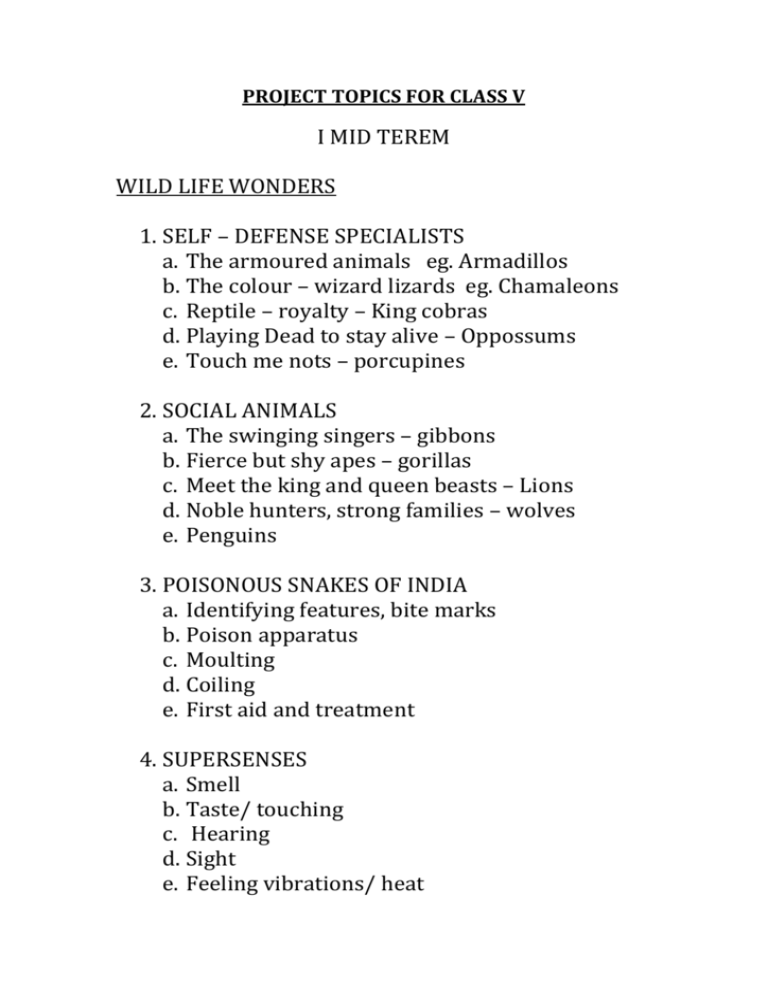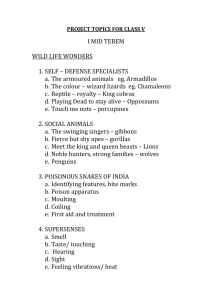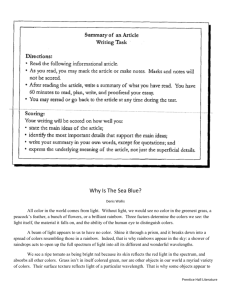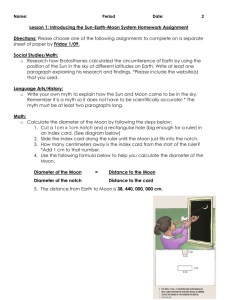project topics for class v
advertisement

PROJECT TOPICS FOR CLASS V I MID TEREM WILD LIFE WONDERS 1. SELF – DEFENSE SPECIALISTS a. The armoured animals eg. Armadillos b. The colour – wizard lizards eg. Chamaleons c. Reptile – royalty – King cobras d. Playing Dead to stay alive – Oppossums e. Touch me nots – porcupines 2. SOCIAL ANIMALS a. The swinging singers – gibbons b. Fierce but shy apes – gorillas c. Meet the king and queen beasts – Lions d. Noble hunters, strong families – wolves e. Penguins 3. POISONOUS SNAKES OF INDIA a. Identifying features, bite marks b. Poison apparatus c. Moulting d. Coiling e. First aid and treatment 4. SUPERSENSES a. Smell b. Taste/ touching c. Hearing d. Sight e. Feeling vibrations/ heat I TERM 1. MOSQUITOES a. Introduction b. Life cycle c. Diseases caused by mosquitoes d. How mosquitoes spread diseases e. Prevention of breeding of mosquitoes 2. FOOD a. Energy giving food, Body building food Protective food b. Balanced diet c. Food pyramid d. Malnutrition e. Junk food and obesity 3. SPACE a. The big bang b. Galaxies c. Stars and nebulas d. Supernova e. Black hole 4. SOLAR SYSTEM a. Sun b. Planets c. Satellites( types and uses) d. Comets e. Meteorites and asteroids II MIDTERM 1. SEED DISPERSAL a. Definition b. Air c. Water d. Animals e. Explosion f. Necessity 2. CARNIVOROUS PLANTS a. Introduction b. Why they feed on insects. c. Drosera d. Venus fly trap/ Sun dew e. Pitcher plant (with mechanisms) 3. NATURAL DISASTERS- VOLCANO a. Introduction b. Where are they found? c. What causes volcanoes? d. Volcanic eruption e. Volcanic hazards 4. TORNADO a. Introduction b. How are they formed? c. When and where do they occur, how are they measured d. Damages and safety tips e. Any 2 deadliest tornadoes II TERM CONSERVATION 1. Conserve water 2. Conserve forest 3. Conserve electricity 4. Conserve fossil fuel 5. Reuse Reduse Recycle CLASS VI PROJECT TOPICS I MIDTERM 1. CRUELTY TOWARDS ANIMALS FOR HUMAN LUXURY a. Introduction b. Animals killed for fur c. Animals killed for skin d. Government laws to prevent animal cruelty. e. Alternative products 2. FIBRESa. Metal fibres b. Mineral fibres c. Fibre Glass d. Rayon e. Polyester 3. SERICULTURE a. Introduction b. Life cycle of silk worm c. Steps in silk production d. Types of silk e. Uses 4. WOOL FIBRE a. Where does wool come from? b. Properties of wool c. Steps involved in processing of wool d. Types of wool e. Uses I TERM 1. FOOD ADULTERATION a. Introduction b. Adulterants in daily life c. How to detect adulteration in food? d. Hazards e. Steps to prevent adulteration? 2. FOOD PRESERVATION a. Introduction b. Need of food preservation c. Types of preservatives d. Methods of preservation( any 4) 3. STEM MODIFICATIONS a. Tuber b. Rhizomes c. C. Corms d. Bulbs e. Stolons 4. ROOT MODIFICATIONS a. Fleshy taproots b. Tuberous roots c. Prop root d. Stilt roots e. Breathing roots II MIDTERM WORKING MODELS 1. Electric bell 2. Torch 3. Conductivity tester 4. Based on magnetism 5- 8: Habitat diaorama( Plants, animals and their adaptations) Desert Grassland Mountain Fresh water II TERM 1. Reduce, reuse, recycle 2. Plastic- essential evil of society 3. Hydroelectricity 4. Pinhole camera 5. Periscope 6. Model of eye 7. Motion 8. Solar and lunar eclipse Colors of Light Visible light is the part of the electromagnetic spectrum that our eyes can see. Light from the sun or a light bulb may look white, but it is actually a combination of many colors. We can see the different colors of the spectrum by splitting the light with a prism. The spectrum is also visible when you see a rainbow in the sky. The colors blend continuously into one another. At one end of the spectrum are the reds and oranges. These gradually shade into yellow, green, blue, indigo and violet. The colors have different wavelengths, frequencies, and energies. Violet has the shortest wavelength in the visible spectrum. That means it has the highest frequency and energy. Red has the longest wavelength, and lowest frequency and energy. Light in the Air Light travels through space in a straight line as long as nothing disturbs it. As light moves through the atmosphere, it continues to go straight until it bumps into a bit of dust or a gas molecule. Then what happens to the light depends on its wave length and the size of the thing it hits. Dust particles and water droplets are much larger than the wavelength of visible light. When light hits these large particles, it gets reflected, or bounced off, in different directions. The different colors of light are all reflected by the particle in the same way. The reflected light appears white because it still contains all of the same colors. Gas molecules are smaller than the wavelength of visible light. If light bumps into them, it acts differently. When light hits a gas molecule, some of it may get absorbed. After awhile, the molecule radiates (releases, or gives off) the light in a different direction. The color that is radiated is the same color that was absorbed. The different colors of light are affected differently. All of the colors can be absorbed. But the higher frequencies (blues) are absorbed more often than the lower frequencies (reds). This process is called Rayleigh scattering. (It is named after Lord John Rayleigh, an English physicist, who first described it in the 1870's.) Why is the Sky Blue? The blue color of the sky is due to Rayleigh scattering. As light moves through the atmosphere, most of the longer wavelengths pass straight through. Little of the red, orange and yellow light is affected by the air. However, much of the shorter wavelength light is absorbed by the gas molecules. The absorbed blue light is then radiated in different directions. It gets scattered all around the sky. Whichever direction you look, some of this scattered blue light reaches you. Since you see the blue light from everywhere overhead, the sky looks blue. As you look closer to the horizon, the sky appears much paler in color. To reach you, the scattered blue light must pass through more air. Some of it gets scattered away again in other directions. Less blue light reaches your eyes. The color of the sky near the horizon appears paler or white. Second supermoon of 2014 will be visible on Friday IANS | Jan 28, 2014, 07.43 PM IST 24 comments Share More 0 inS hare A A READ MORE SPACE Foundation|Astrologer|Supermoon A supermoon is the coincidence of a full moon (or a new moon) with the closest approach the moon makes to the Earth at Gandhi nagar junction at kanjurmarg in Mumbai. (File photo) NEW DELHI: The second of the five supermoons of 2014 would be visible on Friday, an organization working for popularizing astronomy said here Tuesday. Space Foundation said the first supermoon of 2014 appeared Jan 1 - making January the single calendar month with two supermoons until January 2018. Friday's supermoon would be visible around 3.30 p.m. The remaining three supermoons will be visible July 12, Aug 10 and Sep 9. The one in August would be closest to Earth. "A supermoon is when the moon makes its closest approach to Earth in its orbit than usual. It appears as much as 14 percent bigger and 30 percent brighter," said Space Foundation president C.B. Devgun. According to the organization, the term supermoon came from astrologer Richard Nolle over 30 years ago in 1979. During the phenomenon, the Earth, moon and sun are all in a line, with the moon in its nearest approach to earth. Prior to 1979, supermoons were called perigee full moon or perigee new moon. Post a comment







